This month our correspondent Hazel Randall takes a close look at the world of disabled shooting….
Target shooting is one of the most inclusive and adaptable sports. In the last 20 years, there’s been a tremendous change in attitude towards disabled sport in general, heavily influenced by dedicated individuals who join together to form strong support systems. To understand where it all began, let’s go back to the 1940s, to the father of the Paralympic Games…
The Paralympic Games
Sir Ludwig Guttmann (1899-1980) was a brilliant German neurologist and passionate advocate of physical exercise as a means of therapy for injured military personnel. Dr Guttmann, a Jewish refugee, set up the National Spine Injuries Centre at Stoke Mandeville Hospital, in Buckinghamshire. This specialist unit, opened in February 1944, became the birthplace of revolutionary new therapeutic systems, which focussed on the building of physical strength and self-respect.
On July 29th 1948, as the Olympic Games were officially kicked off in London, the very first Stoke Mandeville Games were being held at Stoke Mandeville Hospital. Organised by Dr Guttman, this competition was a sporting arena for wheelchair athletes from all over the UK – a harbinger of great things to come. When Dutch ex-servicemen joined the competition in 1952, the event became known as the International Stoke Mandeville Games.
In 1960, Dr Guttman held the 9th Annual International Stoke Mandeville Games in Rome, alongside the Olympic Games, and from then on, the newly named Paralympic Games have taken place every four years. Since the 1988 Games in Seoul, Korea, the Paralympics have been held in the same host city as the Olympic Games, and the two competitions have been united.
The word Paralympic is a blend of Olympic with the prefix para- (Greek: ‘beside’), denoting alteration or modification.
The Disabled Shooters Group
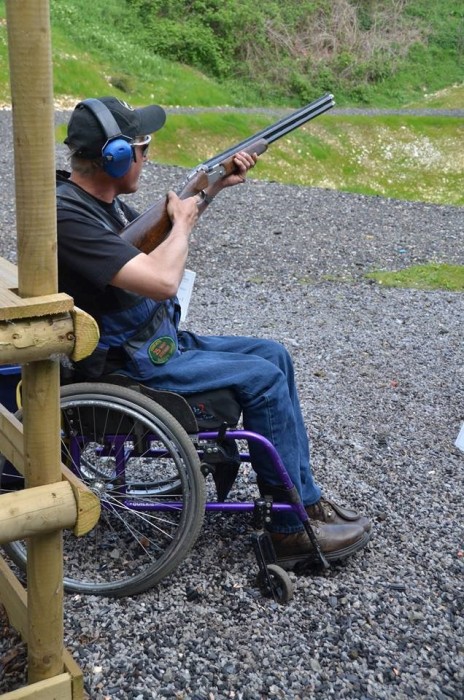 DSG President Adrian Last in action
DSG President Adrian Last in action
Richard Scott was a keen skeet shooter. According to Mr Scott’s wishes, donations collected at his funeral in 1995 were used to fund a have-a-go disabled shooting event at Sandringham Shooting Ground, in Norfolk. At the time, Sandringham Shooting Ground was managed by Graham Brown, whose wife, Yvonne, arranged for participants to be accommodated overnight at a nearby nursing home, where she worked.
The success of this event led to others of its kind, and it was not long afterwards that the Disabled Shooters Group (DSG) was founded by Adrian Last and Brian Wilkie, two friends who first met at the event sponsored by the late Richard Scott. Brian Wilkie suffered from a severe form of Multiple Sclerosis (MS) and died in 2005.
In 1984, at just 24 years old, Adrian Last had a serious motorcycle accident, which resulted in a paralysed right arm and the amputation of his right foot. The following year, having regained the use of his arm, Adrian got back on a bike and resumed the sport he loved: endurance racing.
“With my prosthetic foot, I had no toe movement, and couldn’t operate a foot brake, so my bike was adapted for me. The rear brake was controlled by a lever on the left handlebar, and I continued to compete in national competitions, alongside able-bodied motorcyclists.”
But in 1990, another terrible motorcycle accident left Adrian even more damaged. After lying unconsciousness for eight days, he awoke to discover that two of the vertebrae in his neck had been broken, and that he had lost the use his legs; he would never again be able to ride a motorcycle. But two years later, at the motorcycle club’s annual clay shoot, 32-year-old Adrian was launched into his next passion: clay shooting.
“I’d shot before. Being a farmer’s son, I was handling guns from 11 or 12 years old, shooting pigeons and rabbits on the farm. But it had been a while!”
Last year, Adrian won the World English Sporting and the World Sport Trap titles, bringing his total world golds to five. He has also won one European and many British gold medals, and was the first winner of the CPSA award for Disabled Shooter of the Year. Fifty-seven-year-old Adrian is the DSG’s life president and a determined campaigner for disabled shooting. Over the last 20 years, he has helped to bring the CPSA’s attention to this area of the sport, and his efforts have contributed to increased accessibility of shooting sports in the UK.
He said, “I don’t mind what you ask about my disabilities. If talking about this inspires somebody to get into shooting sports, then I’m happy.”
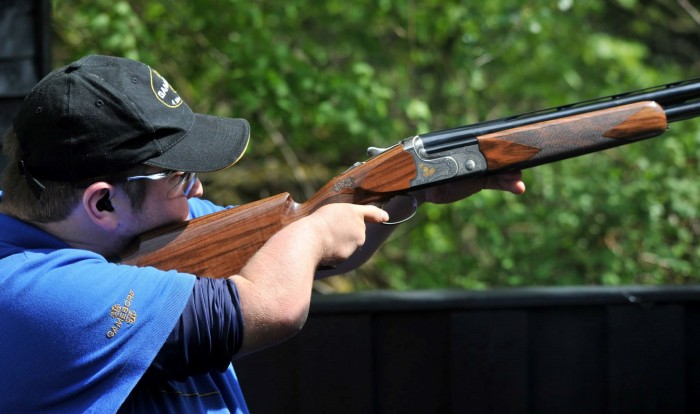 DSG Secretary Sam Nunn takes aim with some clay shooting
DSG Secretary Sam Nunn takes aim with some clay shooting
Sam Nunn is the DSG’s current secretary, responsible for organising shooting events. Three of Sam’s limbs are affected by a very rare syndrome called femur-fibular-ulna complex, and he has been using a prosthetic leg since he was just 15 months old. Sam, who won the CPSA’s Shooter of the Year award in 2014, has been shooting from the age of 12.
“I used to go out shooting rabbits and pigeons with my uncle. But when I was 17, I fancied having a go at clay target shooting, so I started looking around for a club. There were very few clubs that were accessible to disabled shooters, and certainly none near me.”
I asked Sam if things have changed in that respect.
“Yes. I’ve noticed, over the last few years, that attitudes towards disabled shooters have improved a lot. Of course, some disciplines are more accessible than others. For example, an Olympic Trap is shot from a concrete pad, which is easier for wheelchair users than grass.”
Sam told me that he has to choose his gun carefully.
“Because my arms are short, I opt for a gun with a shortened stock, which is typically designed for ladies; I’ve always been able to find something to suit me. For some, though, no gun off the shelf will be suitable, but it’s possible to obtain models with specially made stocks or electric triggers.”
The Disabled Shooters Group is the national body for disabled clay target shooting and is in partnership with the Clay Pigeon Shooting Association (CPSA). If you would like to get in touch with the DSG, please contact Sam Nunn at Sam.Nunn@isgplc.com.
Target Shooting is Accessible, Inclusive, and Integrated
Mick Kirby, of the Sussex CPSA committee, who had his lower left arm amputated, following a stroke, has been instrumental in arranging have-a-go days for people with disabilities.
“We ran one of these events last September, which was really well attended. There was a boy with autism, who particularly enjoyed the experience, thanks mainly to one of our members, who forged a good connection with the boy. This lad’s father was really chuffed.”
Mick told me, “Sometimes I’ll bump into someone at a competition, who’s still shooting after being introduced to the sport at one of our events. I don’t know if this particular boy has continued to shoot. I hope so.”
Mick is a determined character and has worked out a way of loading his gun one-handed, with the aid of a hip holder. At national competitions, he has won gold and silver medals in British skeet and American skeet, and he is also a referee. Mick is committed to promoting shooting for people with disabilities, but actually has a very positive view of the sport’s inclusive nature.
“The majority of clubs include everyone, without discrimination. Over the last few years, I’ve seen a positive change in attitude.”
I asked Mick how he will continue to promote disabled shooting. His reply was simple.
“I promote the sport best by shooting as an able-bodied shooter.”
Matt Skelhon
Matt Skelhon is a 32-year-old Paralympic gold medallist, whose first experience of target shooting was at the annual Inter Spinal Unit Games at the Stoke Mandeville Stadium.
Matt spent four months at the Princess Royal Spinal Cord Injuries Centre, Sheffield, after breaking his back in a road traffic accident when he was just 21 years old. The injury caused paraplegia, which is paralysis of the lower body. With lots of support from family and friends, Matt’s outlook was optimistic, and he made every effort to hurry up his recovery so that he could get on with life.
“I was always positive; I never despaired. I was pretty lucky.”
As part of his rehabilitation, Matt had a go at wheelchair basketball and archery, but it was during the WheelPower Inter Spinal Unit Games at the Stoke Mandeville Stadium, in April 2006, that he discovered a passion for target shooting. And he was very good at it!
He told me, “I’m a bit of a perfectionist, and I like a challenge.”
Two years later, the British National Anthem was playing at the 2008 Paralympic Games in Beijing, China, as Matt received a gold medal for the 10m air rifle event in the SH1 classification. SH1 is for competitors who do not require a shooting stand.
“I felt absolute elation. Leading up to the competition, I’d been focussing on training, just thinking about the job in hand. It had been all about the shooting. And then, suddenly, here I was, with a gold medal round my neck. It was surreal!”
At the 2012 Paralympics in London, Matt won silver and bronze in the 10m and 50m air rifle events respectively, and he also competed in the 2016 Games in Rio de Janeiro, Brazil. He was named Sportsman of the Year by the Peterborough Telegraph. The Pellpax team wishes him well for the 2020 Paralympic Games in Tokyo, Japan.
John Kelman
John Kelman is an amazing man. He takes the concept of thinking outside the box to a place where you can’t even remember what the box looks like.
When he began his coaching career, John was confronted with a hurdle that he has had to overcome many times during his life: dyslexia. Intelligent, compassionate, and innovative, John struggled with the reading and writing aspect of studying for coaching qualifications, but this difficulty was certainly not going to get the better of him. He persevered, and now holds the position of Regional Coach – the highest coaching level recognised by the National Small-bore Rifle Association.
John was determined to provide coaching to people with disabilities. “In the year 2000,” he said, “most shooting clubs didn’t want to know about anyone with a disability – so I started my own club.”
John has designed and constructed shooting aids for many very different needs, and each of his innovations must be ratified by the NSRA to ensure that users are not given an unfair advantage in competitions.
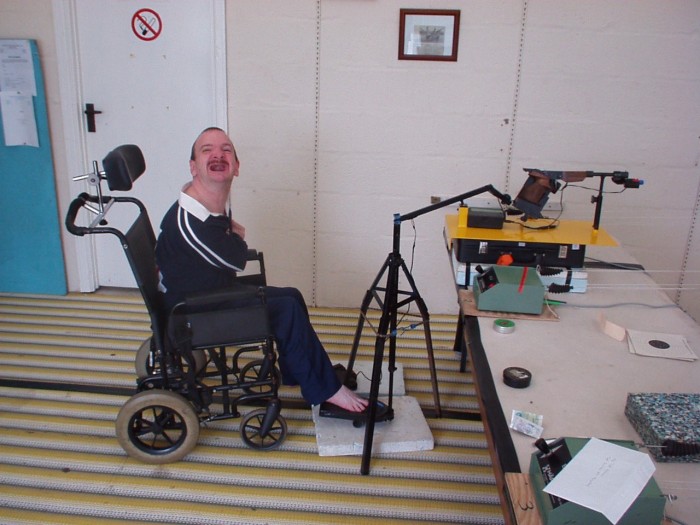 DSG Shooter Eirian uses his feet to aim and shoot.
DSG Shooter Eirian uses his feet to aim and shoot.
Eirian, who had cerebral palsy, had very little control over most of his body, including his head. This meant that he couldn’t focus his sight on the target, aim the gun, and pull the trigger, all at the same time. John told me, “He was trapped in his own body.”
However, Eirian had good control of his ankles and feet – in fact, he propelled his wheelchair with his toes. So John devised a way for Eirian to manoeuvre the barrel of the gun by means of a treadle, which he also used to operate the trigger. John fixed a laser onto the barrel, so that Eirian only had to watch the target; when the laser hit the centre, he’d shoot.
Another student, also with cerebral palsy, was 21-year-old Paul, whose hands were turned outward at an extreme angle. “Paul can’t turn his hands,” the carer told John. “He’s never seen his palms.” John borrowed a lace from the carer’s shoe and looped it around Paul’s wrist; with assistance, Paul then had control over pulling the trigger.
John went on to construct a tidier and safer mechanism for Paul to use – “I called this the Equaliser, as it made disabled shooters equal with able-bodied shooters.” But it was probably that first taste of achievement that brought Paul back again for another go.
And then there was Vic.
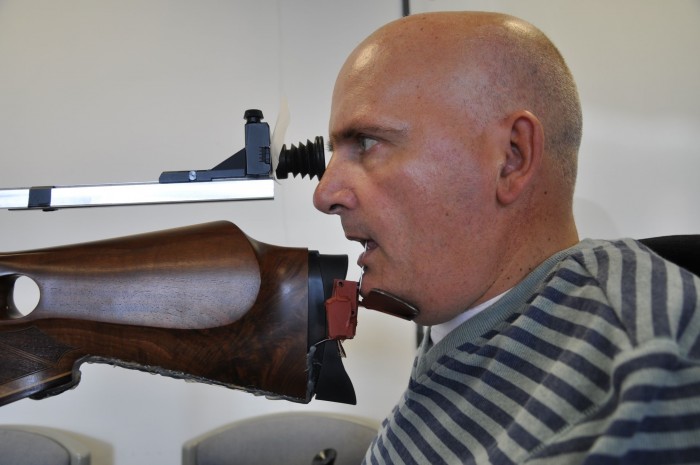 A close up of shooter Vic Morris, in action
A close up of shooter Vic Morris, in action
“I was approached one day by an elderly gentleman who said he’d read an article about me in the local paper. ‘Can you get my son shooting?’ he said. I said, ‘I’ll give it a go.’ I was expecting a little lad, but then in comes a grown man, operating his wheelchair with his chin. I went to shake his hand, and he said, ‘Nothing works, mate.’ Within a week I had this man shooting; within 12 months he was entering national competitions.”
Vic Morris was 28, married, and a father of two little girls when his neck was broken in a rugby scrum, leaving him paralysed from the neck down.
John built a complex machine, whereby the gun was fixed into a support, and the end of the barrel was weighted. A butt plate supported a bracket that in turn supported the stock, and because Vic had excellent control of his head muscles, he could press the stock down with his chin, levering the other end up. Vic’s wife loaded the gun for him, and the trigger was connected to a switch, which Vic operated with his tongue.
Vic Morris became a very good shooter, and he and John were close friends. Vic died in July this year.
As I thanked John for taking the time to talk to me, he said, “I have a challenge for anybody with a disability. Come and see me, and I’ll do my very best to get you shooting – whatever your disability. Just contact me at pistolcoachjk@gmail.com.”
British Blind Sport
 Trial shooter, Paul, takes aim with the specialist equipment
Trial shooter, Paul, takes aim with the specialist equipment
A quarter of a century ago, nobody in the UK with visual impairment was shooting, but in 1994, Ken Nash, a life member of both the National Small-bore Rifle Association (NRSA) and British Blind Sport (BBS), introduced shooting for the blind into the UK. There are now more than 30 centres across the country that welcome visually impaired shooters. Working alongside these clubs, BBS organises competitions, supports the education of school teachers, and provides classifications to blind and partially sighted athletes.
In the Summer 2017 issue of the NSRA’s in-house magazine, On Target, Ken introduces Ecoaims Vis500, a new audio aiming device that has been chosen by the NSRA for visually impaired shooting in the UK. An infrared LED is placed near the target, and the Vis500 converts the infrared signals to audio waves. Via his sense of hearing, the shooter’s skills of calculation, concentration, and steadiness can be tested to the same extent as those of a sighted shooter.
Michael Whapples
One of the experts involved in the selection of the Vis500 was Michael Whapples. Michael has been almost totally blind since birth. He attended a special school for visually impaired children, where he first experienced the joys of target shooting. He showed enormous aptitude for the sport, and it became his passion.
Studying physics at Nottingham University posed problems – and not only for Michael. One of his tutors, Janette Dunn, published a paper entitled Teaching a Physics Laboratory Module to Blind Students, in which she analysed the problems posed by lack of vision. Michael was one of two subjects in her case study, and, in reading this interesting article, it becomes apparent that a huge adversity like blindness does not always outweigh copious amounts of talent, common sense, and intelligence.
Michael’s ‘day job’ is developing software for producing brail documents. Other software projects include a Smart phone app that provides an audio compass for visually impaired sailing, and an app to allow configuration of the VIASS aiming system. But Michael, like so many of the experts I’ve spoken to, embraces the flexibility of this sport.
“In target shooting, visual impairment doesn’t necessarily have to go down the audio route. Shooting can be adapted in so many ways – for example, those with some useful vision can do disciplines such as benchrest shooting, where a scope is permitted. Also, when thinking about this, whilst I know of no shooter using it, blind archers use the ‘back of the hand’ tactile sighting system, which provides a reference point for elevation. Maybe this method can be adapted for shooters.”
Steven Richardson
Last year, I had the pleasure of talking to Steven Richardson, who lost both legs and five fingers in an IED explosion in Afghanistan in 2010. Steven was part of an eight-man team who cycled 3051 miles across the USA, raising £100,000 for Help for Heroes. He participates in several sports, including shooting. You can read The Big Interview: Steven Richardson here.
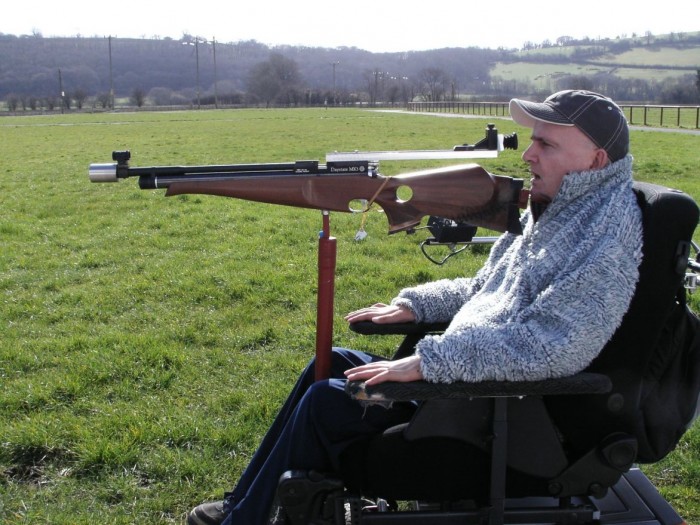 In Memoriam, Vic Morris
In Memoriam, Vic Morris
Many thanks to Dave Froggett, the NSRA (National Small-bore Rifle Association) Coaching and Development Manager, for putting me in touch with many of the people who contributed to this article.
In memory of Vic Morris
